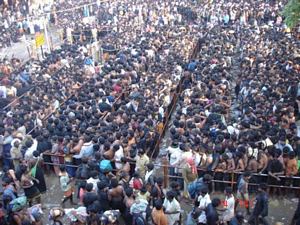 |
| Narendra Modi inaugurating Vibrant Gujarat summit |
Convening global investors’ meets had become a fad of state governments in India
It is in this context that the ‘Vibrant Gujarat’ summit convened by the Gujarat state government failed to attract public interest in the beginning. We thought it to be just another such drama we come to see annually. But this one has opened up tremendous potential and even if half of the proposals get to see the light of day, Gujarat would have advanced much much further in the industrial map of Asia (yes, surpassing all other Indian states). We will not briefly consider what the summit is and the gains the people of Gujarat has gained from it.
This is the 5th Vibrant Gujarat meet which commenced in 2003 and convened biennially. So far, the total investment proposals total Rs. 16,65,000 crores (US$ 370 bn). The assembly of prominent businessmen were conducted on Jan 12-13 this year at the newly constructed Mahatma Mandir, which is dedicated to the Father of the nation and illustrates his ideals in sculptures strewn around the main building. The convention centre spreads over 60,000 sq. metres in area and boasts of a seating capacity of 5,000. Representatives from nearly 30 MNCs, 16 countries and 19 Indian states participated in the two-day affair. Noted among them were 15 enterpreneurs from Pakistan
7,936 MOUs were signed during the meet, totalling a commitment of Rs. 20,83,000 crores (US$ 450 bn) which would generate jobs to the tune of 5.2 million. Power, manufacturing, urban development and infrastructure were the prominent sectors which attracted investors. Proposals for 42 power projects in the state were laid down. Dedicating the 5th summit to youth and women, Chief Minister Narendra Modi said the state would soon lead India Gujarat under the leadership of Narendra Modi, which should be a model to all chief ministers.
A curious comparison with Kerala’s Chief Minister V S Achuthanandan is not beside the point. The veteran communist stalwart had proved to be a big zero in administration and development, being famous only for outdated communist rhetoric. He himself is not corrupt, but the administrative machinery over which he presides over is neck-deep in it with himself impotent to do anything about it! I wonder whether these people can even correctly count the number of zeroes in the huge number of Rs. 20.83 lakh crores which is pledged for Gujarat !










